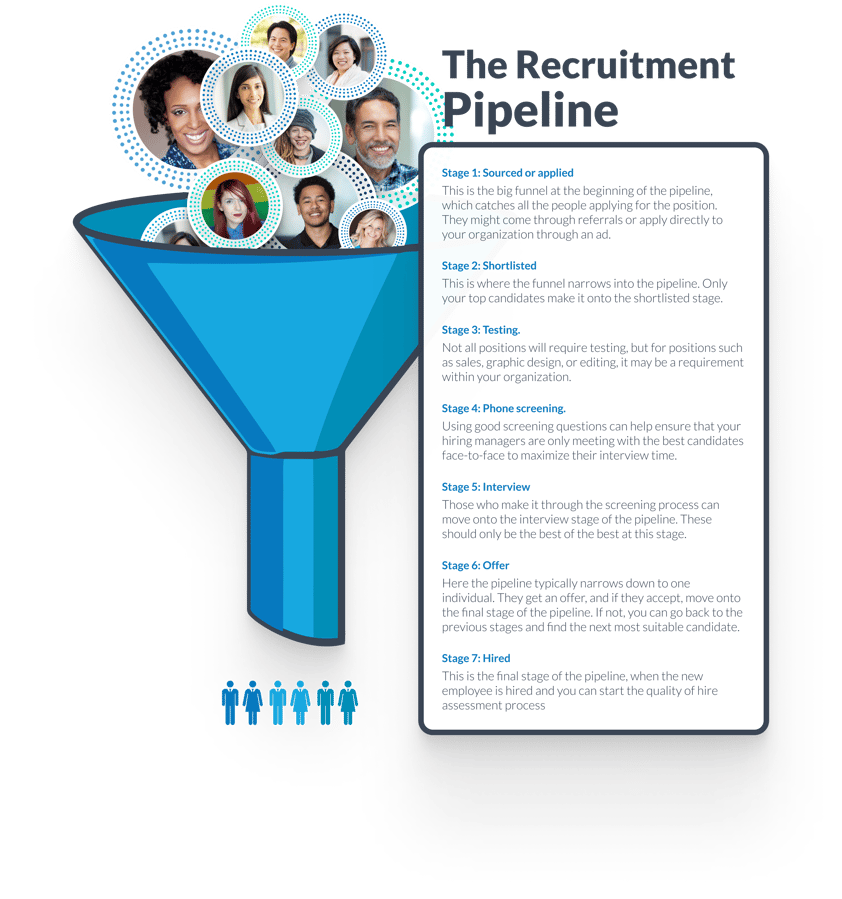

Crosschq Blog
The Importance of Recruitment Pipeline Data

The recruitment process is more important than ever in planning your workforce. CNBC reports that there are over 10 million job openings in the United States, with the number of people leaving their jobs at the highest rate since the start of the millennium.
It's called The Great Resignation, and employees are more willing to walk away from a job they aren't satisfied with because another one is out there waiting for them. There are more jobs than workers, so it's a candidate’s market when it comes to finding an open position. Recruiters are working harder (and smarter) than ever to find the most talented candidates possible for open positions in their organizations.
Having an active and healthy talent recruitment pipeline can help with this process. But what does that look like? And what data can you get from the talent pipeline to make the recruitment process even better? In times when recruiting top talent is tougher than ever, it's important to give your recruitment pipeline your full attention.
Understanding the Recruitment Pipeline
The recruitment pipeline is the process candidates move through during the hiring process. The pipeline starts with a funnel, where a number of candidates are either sourced, referred to you, or apply for an open position you've advertised.
From this large funnel, they start to move through the pipeline, going from stage to stage in the recruitment process until they are either hired, accept another position, or are removed from the process because they aren't suitable for the position.
Each open position in your organization should have a separate recruitment pipeline. This allows you to have a different recruitment pipeline process and a different set of candidates depending on the position for which you are hiring.
For example, the recruiting pipeline might look slightly different for a sales position compared to a C-suite position. You'll want to track each candidate through the pipeline so that you know what stage they are at and how long they've been there.
A recruitment pipeline might look something like this: 
It's important to keep your pipeline filled, even if you have someone in the offer stage of the process.
Because the job market is competing for talent, you don't know when your top candidate could drop out of your pipeline by accepting an offer somewhere else. Until they accept the offer and start with your company, it's a good idea to keep adding fresh candidates into the pipeline. That way, you know you have more qualified candidates if you need them and don't have to start the process all over again.
Consider having a separate pipeline of candidates who you think would be a good match for your organization but might not necessarily have a position for right now. This can help speed up the recruitment process later on when you have a new role to fill.
Recruitment Pipeline Data and How to Use It
You can get a lot of great information from a recruitment pipeline, including:
- Where your potential bottlenecks are in the recruiting process. Maybe a hiring manager isn't scheduling enough interviews, or your assessment process is taking too long. By tracking the pipeline and how long each candidate is in each stage, you can see what's holding the process back. When you remove those roadblocks, you can speed up the entire recruitment process without sacrificing the quality of the candidate.
- How to add more candidates to the pipeline. When you look at where candidates are entering the funnel, you can see where the gaps are in your recruitment strategy. Maybe you are getting all your candidates through referrals but aren't doing enough advertising on sites like LinkedIn. Knowing where the holes are in your recruitment strategy can help you effectively fill them.
- How to find the highest-quality candidates. Paying attention to data within the recruitment pipeline can show you where your best candidates are coming from and how they move through the pipeline to the hiring stage. This might show you that your best candidates come from social media ads, for example. With that knowledge, you can focus more of your recruitment budget on those ads and find more quality candidates for the next open position.
At its most basic, the recruitment pipeline is an easy way to visualize the recruitment process. You can track metrics and improve your recruitment tactics so that you are getting higher-quality candidates for every position.
Want an easy way to visualize and track your recruitment pipeline? Check out Crosschq Recruit, a 100% opt-in candidate referral network that creates a qualified talent network with dynamic job matching.
To see how we can help build a better recruitment pipeline for your organization, schedule a customized demo with a Crosschq team expert.
Take the Guesswork
Out of Hiring
Schedule a demo now



%20-200x43.png)






